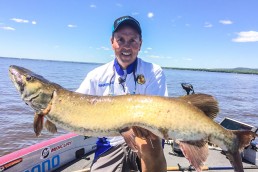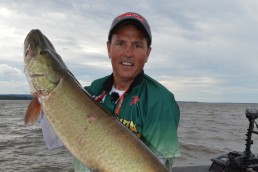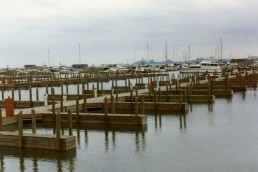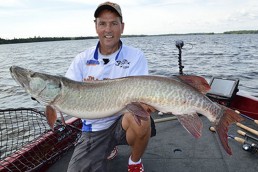SHARE THIS POST
While filming The Musky Hunter television show, I rely on years of data from my fishing logs, moon phases and insight from local guides and resorts to help plan my trips. Generally, by April 1 our schedule is set and there is no chasing hot bites during the season, or sending in a scout team to dial-in the pattern. We arrive and have to deal with the existing conditions, and try to catch muskies.
Last summer Tom Sullivan and I arrived at one of our favorite summer haunts only to find that big rains and a cold spring had muddied the water and delayed weed growth. Then, what came from nowhere was a forecast for three days of giant wind. Sitting at breakfast that morning, our spirits went from high to low, as we could see the tree branches moving and the white sky to the west, which is a telltale sign of building winds. Fortunately, by the end of breakfast we had managed to give ourselves an attitude adjustment, and changed our mindset to making the most of the situation. Our approach was to focus on spots that were fishable, using some bigger and bolder colored baits. Over the next couple days, we ground it out and managed to find one large spot that was fishable and produced a bite each day at moon underfoot and moonrise. Given the wind, we only had a handful of spots to fish, so we cycled through them, switching lures and changing approaches, fishing them deeper and shallower each time. The pattern was simply fishing hard, staying focused and counting on that one spot to produce! The trip was a struggle, but perseverance and paying attention to detail, which really was ensuring we fish a particular spot during prime daily moon periods produced muskies on queue, and we filmed a great episode.
A successful muskie season relies on having an arsenal of strategies in your mental hard drive, and the willingness to make adjustments when necessary. Here’s a few strategies to consider this summer, that will help you put a few more muskies in your boat.
Drop to 9s
As many of you are aware, I am a big fan of fishing Cowgirls when fishing any big-muskie water. This lure has proven itself time and time again as a trophy muskie weapon. There is no question that when the muskies are active, there simply isn’t a better lure to cast. However, we know the muskies aren’t always active. Over the last five or six years, I have definitely seen a trend that when the muskies are located around shallow cover that downsizing to a size 9 blade, such as a Junior Cowgirl, is usually all it takes to start getting muskie action. It’s interesting that downsizing to size 8 blades hasn’t seemed to have the positive response the 9 blades have produced. Currently, there are lots of guides (and savvy weekend warriors) utilizing double 9s. So, I would make a point of stocking up on a few before your trip.
Extend the spot
We all spend time on the water trying to find spots that hold muskies. Throughout the day, if I am approaching a spot where I have seen or caught muskies, I make a point of trying to extend the spot. If a spot seems to recycle rapidly and muskies tend to show up most of the time you fish the spot, it could be you have encountered a pack of muskies working the spot. So, rather than pulling up right to the sweet spot, extend the spot by starting 100 yards from your cluster of waypoints. It’s amazing how this approach will let you find other muskies nearby. In the evening, you can now return to multiple waypoints on a spot where you saw or caught muskies. Also, if the spot is frequently fished by others, more than likely the area you found that extends the spot will not have been fished. So, you can drive by the spot while others are fishing and return after they leave, knowing you have another sweet spot that’s holding a muskie.
Adjacent spots
While on the subject of extending the spot, an often more effective approach is looking for adjacent spots that might hold muskies. Last summer, one early evening, we found muskies relating to points that were relatively sharp breaking and not “traditional” summer spots. After catching one muskie from such a spot, we visually looked around and drove to four adjacent points that looked similar both visually and on the map chip. Amazingly, all of the other four points held muskies that evening, and it was a great end to the day. The next day the pattern changed and the muskies were not using these points, however, it was a lesson in searching for adjacent spots to capitalize on the situation.
Are you enjoying this post?
You can be among the first to get the latest info on where to go, what to use and how to use it!
The more traditional approach to searching for adjacent spots is to look for a nearby reef or point if you find a bay holding muskies. Likewise, if muskies are using a particular point, look for an adjacent bay to hold muskies, particularly if the muskies seemed to have disappeared from the point. So often, maximizing your day and catching another muskie can happen by simply fishing an adjacent spot.
Plan for a blow
Even though summer is usually associated with stable weather, you more than likely are going to encounter at least one days on your trip in which the wind will be strong. These are the days with 15 to 25 mph winds. Often the gusts are higher. These are the days where your “A” spots are often not fishable. Actually, any open-water, wind-exposed spot may not be fishable. So, you’ll need to rely on your “B”, “C” and even your “D” spots to catch muskies. In summer, the big winds are usually southerly. While planning for your trip and looking at the map, besides looking at your favorite spots, select a few with potential in a big south wind. At the lake, give them a quick check for layout, weed growth, rocks, etc. Keep the spot in the back of your mind. Then when the wind blows, you can return to those spots with confidence that they may be productive.
When you’re faced with a day with giant winds, remember to be safe. You might try getting up early before the wind gets too strong to fish a couple wind-exposed spots, or try and fish them at dark when the wind settles. On some days you have to realize it’s a “plan B” day. Stick to the spots that are fishable and work them several different times. Work the edges and the thick cover, and change casting angles. It might be that you are fishing the same spot three or four times that day, so experiment with lures as well. While on the subject of lures in a big wind, remember to use big, bold baits. You need the lure to get noticed and the muskies to be able to feel the bait. So, consider what lures with those traits are best for the particular spot you are fishing.
Every muskie season is different, as is each trip. As muskie hunters, we all meticulously plan, review maps, research waters and stock up on the best lures we believe will be most productive. However, when conditions aren’t what you expect you’ll need to have some strategies to adapt. Hopefully these will help you turn your day into a multiple-muskie day.
MWO
SHARE THIS POST
Did you enjoy this post?
You can be among the first to get the latest info on where to go, what to use and how to use it!
Jim Saric
Jim Saric is a Legendary Angler in the Freshwater Fishing Hall of Fame, the host and executive producer of The Musky Hunter television series, editor at large of Musky Hunter magazine, a seven-time muskie tournament winner, and a contributing writer for numerous other publications.



